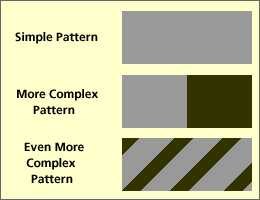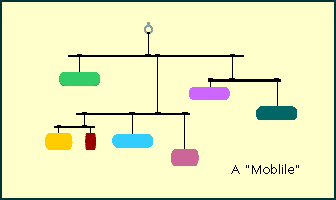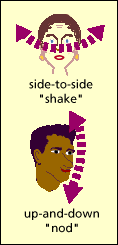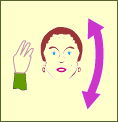
 TUTORIAL: Information
TUTORIAL: InformationINTRODUCTION . DATA . RULES . CODES . UNCERTAINTY . CONTEXT
Small numbers of rules produce simple patterns. For example, given an area of space to be colored, the pattern of Figure 1 can be produced by a single rule:
 While the pattern of Figure 2 requires three rules:
While the pattern of Figure 2 requires three rules:
And the pattern of Figure 3 requires five rules:
The more complex the pattern, the larger the number of rules needed to reproduce it. Human communication appears to be a very complex process, so it would not be surprising to find that it is constrained by a large number of rules.
A rule is a constraint on a process -- that is a requirement that some action be prohibited from happening. The previous examples have presented rules written as negative constraints. This was done to avoid confusion between the idea of a "rule" and the idea of a "command."
It is important to see that rules are not commands. They do not tell anybody what to do; instead, they specify what is illegal, or out of bounds. People are free to do whatever they wish to do within the rules.
However, the rules presented above could just as easily have been written as positive constraints. For example, the rules for Figure 3 could have been presented this way:
Because it is sometimes convenient to do it one way and sometimes convenient to do it the other, this tutorial will express rules in either form. The important thing to remember is that a rule is not an order that tells someone what to do; it is a guideline that prohibits some things but allows everything else.
As an example, consider the object known as a "mobile."

In this case a pattern is formed by the position of a set of colored objects in space. Each different position that the objects take up is a different pattern. Each object hangs on a piece of thread from one of the mobile's arms. The arms and string are the rules of the mobile - they act as constraints and keep the objects' motion limited to certain orbits. Although the objects are constrained from moving up and down, and from moving beyond the boundaries of the bars, they may move to any other point, and this permits an very large number of different patterns to appear.
As a practice exercise, consider the rules that might be found on a U.S. highway:
In each of these cases, the rules bring an organization to the movement
of the objects. They limit movement, but in doing so they
produce a structure that allows the system to exist. This notion of a structure within which a process may produce certain patterns is fundamental to many of the theories that seek to explain human communication. The next section describes one of the most important kinds of communication structure: the code.
![]() 3016
3016

From now on the objects will be called elements, and each set of elements will be called a paradigm.
The next illustration shows a paradigm of two elements:
A code is a set of rules that translates one paradigm into
another. For example, in American culture the physical "nod, shake"
paradigm often is translated into a mental "yes, no" paradigm. A head "nod" translates into the
concept "yes," while a head "shake" translates into the concept "no."
A map is a table or diagram that shows all possible translations of a code. For example, a map of the code we have just described might look like this
| HEAD MOVEMENT | CONCEPT |
| shake | "no" |
| nod
|
"yes" |
Next, consider a more complex code. Imagine that a person walks
 into a noisy, busy taco stand to order three tacos to go. The person behind
the counter says "Tacos?" and the person ordering nods her head and holds up
three fingers. What code is in use here?
into a noisy, busy taco stand to order three tacos to go. The person behind
the counter says "Tacos?" and the person ordering nods her head and holds up
three fingers. What code is in use here?
Clearly, the paradigm has been expanded to contain seven elements: head nod, head shake, one finger, two fingers, ... and so on up to five fingers. The map of the code might look like this
| HEAD
MOVEMENT
|
NUMBER
OF FINGERS
|
CONCEPT
|
| shake
|
none
|
"no"
|
| nod
|
one
|
"yes;
one"
|
| nod
|
two
|
"yes;
two"
|
| nod
|
three
|
"yes;
three"
|
| nod
|
four
|
"yes;
four"
|
| nod
|
five
|
"yes;
five"
|
When elements from a paradigm are combined with one another to form new elements, the new elements are called syntagms. That is, the collection of all of the available singular, fundamental elements is called the paradigm, and the compound elements that are constructed by combining the singular elements are called syntagms.
In this example, a head nod is an element of the paradigm, as is the holding up of one finger -- the result of combining the two into "a head nod and one finger" is a syntagm. Similarly, "a head nod and two fingers," "a head nod and three fingers," and so on are also syntagms that are used in this code.
Communication in its simplest form requires only that a signal travel from a sender to a receiver. However, if the sender wants to transmit a particular thought or idea to the receiver, then there must be a way of matching the contents of the senders mind with the contents of the receiver's mind. This is the role of the code.
Until two people share a code, they are not able to communicate meaningfully with one another. The full power of codes will be seen in the Signs and Language section of this tutorial. The next section describes how the use of codes can produce information.
![]() 1015
1015 ![]() 1036
1036 ![]() 3017
3017 ![]() 3018
3018 ![]() 3019
3019 ![]() 3020
3020 ![]() 3028
3028 ![]() 3029
3029